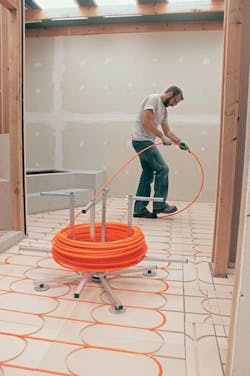Latest from Plumbing Contractor
Sponsored
CHICAGO — I always look forward to my annual visits with Dale Stroud, Senior Director, Marketing and Offerings at Uponor Inc. He gives a clear and concise view of the construction market, and while sifting through the nebulousness of his so-called crystal ball, he concludes with a short-term economic outlook as either a “partly cloudy” or “partly sunny” forecast. I will admit, that inside this “crystal ball” are not just visions of false hope or dreaded despair, yet rather tangible indicators that project economic assessments.
By all accounts, 2018, for both commercial and residential markets — plumbing and hydronics more specifically — call for the ditching of umbrellas. The climate sees partly sunny skies as I hear terms such as “steady” and “positive” growth from manufacturers.
According to John Hazen White Jr., executive chairman of the board & owner, Taco Comfort Solutions, the outlook for all sectors is very positive. The economy, says White, is humming along at a rate we have not seen in many years. Consumer confidence is at record highs, as is the stock market. People are investing in their homes and businesses are investing in their organizations, be it new buildings or mechanical system energy-efficient upgrades.
The Plumbing Heating Cooling Contractors (PHCC), agree with the overall outlook, “PHCC is optimistic about 2018. Overall, the economy looks to be slightly better than 2017 due to solid growth. According to the reports we have seen, residential construction should remain strong while commercial construction growth should be moderate,” said Laurie Crigler, PHCC president and vice president, L&D Associates Inc. in Virginia.
And while construction and housing trends remain positive for the time being and economic growth is steady, we are also seeing some regional shifts in terms of energy utilization, most notably a move away from fossil fuels to electricity. “The positive trend here is that as energy advocates and utility companies work more closely with manufacturers, we can be more responsive in terms of developing and providing the most relevant and efficient products possible to address consumer needs,” says Bruce Carnevale, president and chief operating officer, Bradford White Corp.
Inside the numbers
A report by the National Association of Home Builders has seen builder confidence in the market for newly-built single-family homes increase five points to a level of 74 in December on the National Association of Home Builders/Wells Fargo Housing Market Index (HMI) after a downwardly revised November reading. This was the highest report since July 1999, over 18 years ago.
“Housing market conditions are improving partially because of new policies aimed at providing regulatory relief to the business community,” said NAHB Chairman Granger MacDonald, a home builder and developer from Kerrville, Texas.
In a heated economy with GDP growing up to three percent and beyond, said Carnevale, there could be a tightening of labor markets, increases in material costs, and a more accelerated rise in interest rates.
And while consumer confidence is currently riding a nice little wave, manufacturer confidence is also up. In fact, according to The National Association of Manufacturers (NAM), manufacturers’ optimism has risen to unprecedented heights. With 94.6 percent of respondents saying they are positive about their own company’s outlook, the fourth quarter’s optimism level is the highest in the survey’s 20-year history, and up from a 64.3 percent average in 2016.
Yet, while these numbers are encouraging, don’t throw all caution to the wind. In a heated economy with GDP growing up to three percent and beyond, said Carnevale, there could be a tightening of labor markets, increases in material costs, and a more accelerated rise in interest rates. “A dramatic rise in interest rates could slow down spending, particularly when it comes to first-time home buyers, a trend that is already a concern as many of these potential home buyers are dealing with significant college debt,” said Carnevale.
Plumbing & hydronics forecasts
As for plumbing and hydronics market, based on order funnel, low housing inventory, NAHB data and internal market intelligence, Christian Geisthoff, vice president of market innovations, Viega, believes the short-term economic outlook looks positive. “We are optimistic that the plumbing and hydronic markets will average an increase of approximately four percent. Specifically, we see the residential market for plumbing averaging a four-point increase over the next year while hydronics will sustain two percent market growth. The only difference we anticipate between residential and commercial is that the commercial sector for hydronics will grow at a rate of about four percent vs. two percent,” said Geisthoff.
Uponor’s Stroud agrees overall, saying there should continue to be good growth in residential plumbing as the new housing market is still recovering from the recessionary downturn. “Even though the ‘official’ recession ended more than seven years ago — June 2009 — the housing industry has had a much more protracted recovery.
“In terms of overall activity, the commercial sector has recovered faster than the residential sector and is back above pre-recession levels. Growth has been moderate and steady, but with some geographic regions and segments faring better than others,” said Stroud.
Feedback from specifiers, engineers, contractors and wholesalers, as well as key indicators from resources such as the Architectural Index, indicate that commercial/mechanical contractors are largely backlogged through 2018, says Carnevale. “Also, it is important to note that the bi-partisan focus on infrastructure will likely have both a short- and long-term positive impact for commercial plumbing work,” said Carnevale.
Most are in agreement regarding infrastructure. “The president is very concerned about the country’s aging ‘infrastructure,’ and we reminded him that infrastructure is more than bridges and highways, it is all the underground piping that exists that has been neglected for years,” said Crigler.
“We should also see the often-trumpeted $1 trillion infrastructure bill come to some sort of conclusion in 2018. With bi-partisan support for infrastructure, which includes significant long overdue investments in our water and wastewater infrastructure, it could be another boom for our industry,” said White.
Carnevale said that between currently scheduled workloads and national, state and local infrastructure initiatives, the commercial hydronics outlook, for example, should remain healthy well beyond 2018.
Stroud continues that underfloor hydronic heating is growing with the recovery of the housing market. Since underfloor hydronic heating is used mostly in higher-priced homes, its use is influenced by growth in those market segments that favor higher-value housing. Also, hydronic heating is obviously a climate-zone-dependent market. Thus, with much of the housing growth taking place in “non-heating” markets, the growth of underfloor heating may not fully mirror overall residential construction growth.
Hydronic heating and cooling, whether it involves underfloor systems or the use of combined hydronic and air systems, is showing good signs of growth. It is recognized that hydronic-based heating and cooling systems can provide very good performance from both an operational and comfort standpoint. “In particular, there is a lot of interest in radiant cooling. It offers greater architectural freedom and can significantly absorb a significant amount of the cooling load of a building,” said Stroud.
Tweet this
Let’s face it; it’s sometimes difficult to gauge the government’s performance on the economy without the talking about the president’s overall optics as a whole, from the alleged Russia scandal to his incessant tweeting, but, according to Carnevale, “Overall, despite the clumsiness of some of the administration’s messaging that has tarnished their results, the president deserves credit for taking action on the issues he promised would be addressed.”
From a practical standpoint, said Carnevale, his ability to address regularity issues affecting domestic business growth has been a plus. His administration has also brought about a higher level of cooperation between the regularity bodies and industry, helping to moderate what were once primarily adversarial relationships.
“By doing so, we can work together to bring about policies that are ultimately in the best interest of consumers. I think this change alone has had a significant impact on 2017’s economic growth, even more so than the anticipated tax reform benefits,” says Carnevale.
Taco’s White concurs and says that as a private, family-owned, American-based manufacturing business, the Trump administration, through words and early action, has certainly been focused on his company’s success and the success of U.S. manufacturing businesses in general. “Whether its directives to try and cut red tape or make the tax system more competitive, this administration has reached out to the manufacturing industry and has taken a keen interest in our future success,” said White.
What really remains to be seen, the new tax law could yield positive gains. “With the recent tax law being passed, we anticipate more corporate growth and reinvestments that will aid in the commercial growth,” said Geisthoff.
Work to be done
Labor shortages continue to plague the construction industry, both at the site level but also among suppliers of building products. “From an overall standpoint, you can’t ignore the fact that based both on historical patterns and some isolated economic indicators, there is a chance of a minor recession sometime in the next few years. But right now, nothing suggests a downturn in the near term,” said Stroud.
According to Crigler, while the White House seems genuinely interested in businesses, an Executive Order has been signed that will evaluate and encourage apprenticeship programs. “PHCC was fortunate to have been invited to the White House to discuss workforce issues and help make some recommendations about regulations and tax reform,” said Crigler.
Legislatively, said Crigler, we need to continue to attempt to get the Carl D. Perkins Career and Technical Education Act reauthorized, and promote increasing the funding of this very valuable act as this is where the money comes from that keeps apprenticeship schools in place. Apprenticeship is an additional avenue of education, not better and not worse than college, just less costly and we need to continually make legislators aware of this path for education.
We are pushing educators to try to understand that the trades classes need to be back in the high schools so that our young people have that additional avenue of education. We are asking school boards across the country to reinstitute these classes as the adage “you must go to college to make something of yourself” is not applicable anymore. This industry is full of jobs that are rewarding both emotionally and particularly financially.
“It is going to take a lot of people to ‘fix’ these problems and we as a country need to encourage apprenticeships so that we have high paying, rewarding and satisfying jobs to offer our young people for their future,” said Crigler



